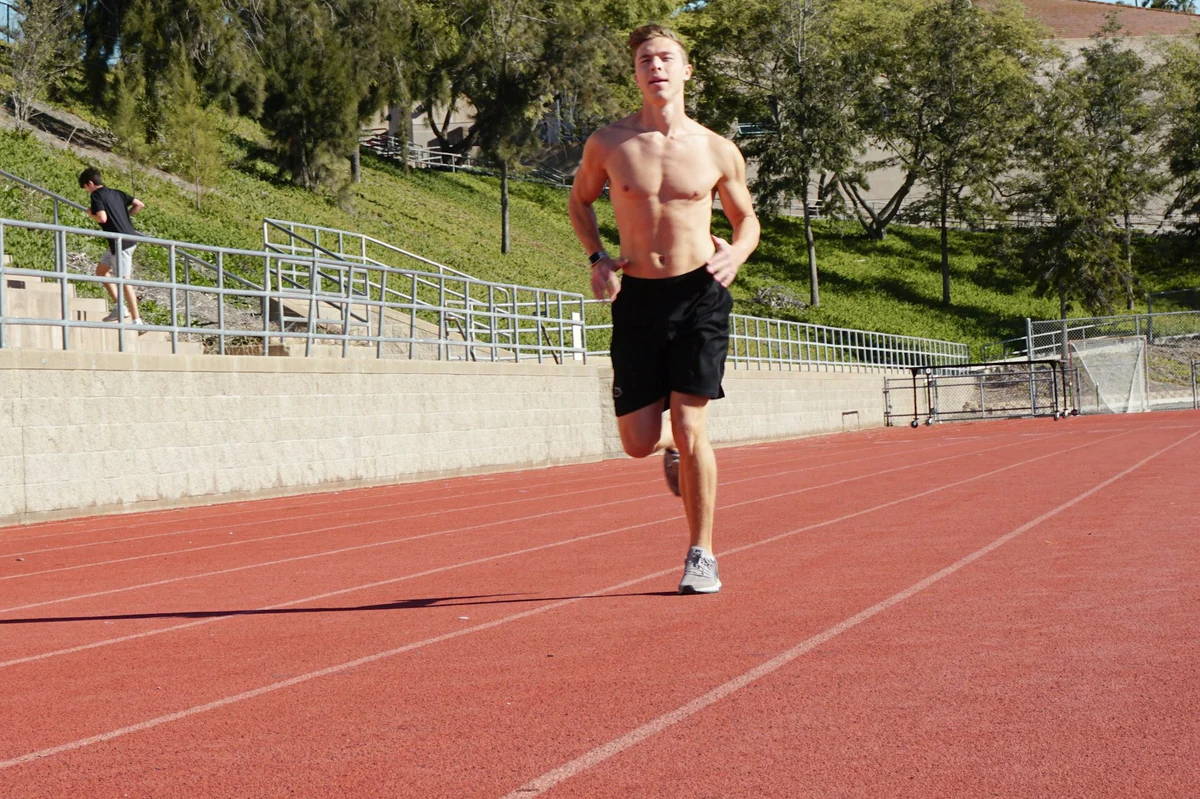Auf der Sprintdistanz, oft auch Volksdistanz genannt, beträgt die Streckenlänge bei der Abschlussdisziplin Laufen in der Regel rund fünf Kilometer. Die dabei erzielten Zeiten bewegen sich zwischen 15 und 30 Minuten für Profis und Einsteiger. Das Lauftempo, die damit einhergehenden koordinativen Anforderungen und die Belastung des Herz-Kreislauf-Systems sind entsprechend hoch, und sollten im Training gezielt angesprochen werden.
Kurz und knackig
Als reine Laufeinheit empfehlen sich kurze Intervalle über 10 x 200 Meter oder 5 x 400 Meter, die mit jeweils maximaler Geschwindigkeit absolviert werden. Da für die maximal umzusetzende Geschwindigkeit eine optimale Koordination von Arm- und Beinarbeit notwendig ist, werden die Erholungszeiten zwischen den Belastungsintervallen verhältnismäßig lang gehalten (doppelte Belastungsdauer). Dadurch könnt ihr euch bei jedem Intervall aufs Neue mental und koordinativ ausreichend vorbereiten.
Und los geht’s
Eine typische Intervalleinheit, die bevorzugt auf der 400 Meter Bahn, alternativ auch auf einem abgemessenen Radwegestück oder ähnlichem durchgeführt wird, könnte so aussehen:
Einheit 1 – Gesamtdauer ca. 60 min
15 min Einlaufen mit 5-10 kurzen Steigerungsläufen über 50-100m
10 x 200 m mit VO2max Intensität, Pause zwischen den Intervallen doppelte Belastungsdauer
15 min Auslaufen oder Ausradeln
Wer derartiges noch nie trainiert hat, der beginnt am besten mit 5 x 200 Metern, um seine Intervallzielzeit zu ermitteln. In der Regel wird erst beim dritten oder vierten Intervall die schnellste Zeit erreicht, da der Körper erst dann auf die erhöhte Bewegungsgeschwindigkeit eingestellt ist. Diese Zeit gilt es in den folgenden zwei bis drei Einheiten über 10 x 200 Meter konstant abzurufen. Aufbauend auf die 10 x 200 Meter können bei verzeichneter Leistungssteigerung auch 5 x 400 Meter gelaufen werden. Hier sollten die 400 Meter dann optimalerweise mit der gleichen Geschwindigkeit wie die 200 Meter gelaufen werden können. Das könnte zum Beispiel so aussehen:
15 min Einlaufen mit 5-10 Steigerungsläufen über 50-100m
5 x 400 m in jeweils 90 s, Pause zwischen den Intervallen jeweils 180 s
15 min Auslaufen oder Ausradeln
Tempowechsel üben
Sprintdistanzen werden immer häufiger im Rahmen großer Triathlonveranstaltungen in Städten vor zum Teil zahlreichen Zuschauern durchgeführt. Abschnitte großer Zuschauerdichte wechseln sich dabei oft in schneller Folge mit Abschnitten geringer Zuschauerdichte ab. Wo viele anfeuern und die Euphorie groß ist, wird das Tempo oft unbewusst und kurzfristig deutlich erhöht. Das ist auch gut so, denn es darf ja Spaß machen! Auf die dadurch bedingten Tempowechsel und Belastungsspitzen sollte man sich aber schon im Training entsprechend vorbereiten. Dafür ist z.B. folgende Einheit besonders effektiv:
Einheit 2 – Gesamtdauer 45-60 min
15 min Einlaufen im Grundlagenbereich
15-30 min Laufen Grundlagenbereich, dabei alle 4 min für eine Minute in das angestrebte Wettkampftempo + 10 % Geschwindigkeitsaufschlag wechseln
15 min Auslaufen oder Ausradeln
Wechseln will geübt sein
Bezogen auf die relativ kurze Gesamtdauer eines Sprintwettkampfs und die Kürze des Lauf-Splits, spielen die Wechselzeiten sowie die möglichst schnelle muskuläre und koordinative Anpassung an den Disziplinwechsel für die Gesamtleistung eine wesentliche größere Rolle, als dies bei den längeren Triathlondistanzen der Fall ist. Daher sind auch einfache Koppeleinheiten für die Gesamtleistung sehr effektiv, z. B. in folgender Form:
Einheit 3 – Gesamtdauer ca. 60 min
10 min Radfahren im Grundlagenbereich
400 m in maximaler Geschwindigkeit nach schnellem Wechsel
10 min Radfahren im Grundlagenbereich
400 m in maximaler Geschwindigkeit nach schnellem Wechsel usw.
Diese Serie wird bis zum sechsten Radabschnitt wiederholt und dient nebenbei auch dem Erlernen einer schnellen Wechseltechnik. Wer über ein Startnummernband verfügt und dieses bereits beim Radfahren trägt, der sollte auf seinem Wechselplatz nichts weiter als ein Paar Laufschuhe mit elastischen Schnürsenkeln, eventuell Socken, eine Laufmütze und ein Gel auf einem Handtuch ausgelegt haben.
Fortgeschrittene können die Einheiten Zwei und Drei natürlich auch als Koppeleinheiten nach dem Radfahren absolvieren. Guten Laufzeiten auf der Sprintdistanz sollte spätestens dann nichts mehr im Wege stehen!




















